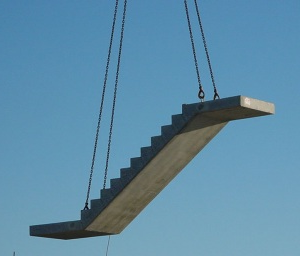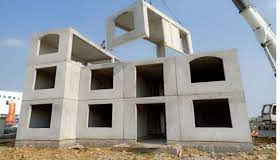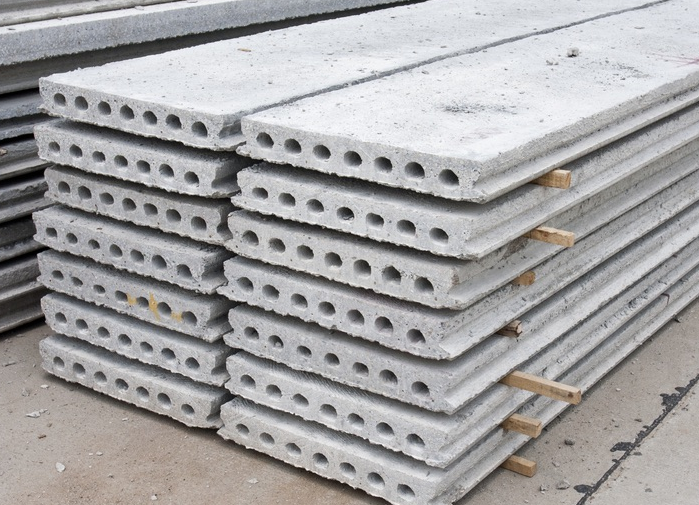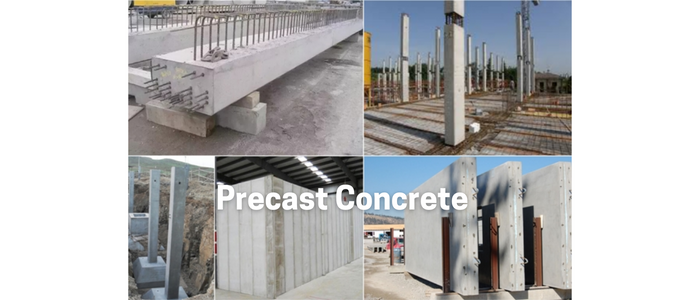What is Precast Concrete?
Precast concrete, as the name may imply, is a concrete that is cast somewhere other than intend location for use. Precast concrete is created off-site using moulds that are reusable in factories with controlled environment. Also, curing of this concrete is made off-site. That is the primary distinction between cast insitu concrete, which is poured directly into its final location on site, and precast concrete.
A precast element can be connected to other precast elements to obtain the complete structure. Examples of the precast concrete elements are:
- Beams
- Walls
- Columns
- Floors
- Staircases
- Pipes

Advantages and Benefits of Precast Concrete
The main corporate goal behind the use of a certain production method is to establish itself in the marketplace by: producing a product better or cheaper or faster than the competition. The optimum situation would be if both targets were achieved.
So, what is the situation with construction using precast concrete elements?
Improved quality of concrete
Production in an indoor environment results in better working conditions with correspondingly better productivity than would be the case on a building site, and that has an effect on quality, too.
Training makes it simpler to make up for the continuous, significant scarcity of skilled workers in the building sector in the context of industrial production.
Steel moulds can be used for standard elements or large batches, which enables a high degree of dimensional accuracy to be attained.
A particular concrete quality can be produced at a factory. Concrete components with architectural textures and colours, particularly for facade designs, can only be produced in factories. Similar to other industries outside of construction, factory manufacturing leads to more effective quality control.
Lower production costs
The main purpose of precast concrete construction is to reduce the cost of the formwork.
The same mould can create many components. Large batches are beneficial, of course. Although mould types that are appropriate for the production technique (such as rigid moulds with minimal fold-down elements) necessitate a design strategy that is appropriate for the production, this does result in a high rate of mould reuse.
Another reason for precast concrete construction was undoubtedly the reduction or total elimination of scaffolding costs.
The use of mechanization and automation in factory production makes it possible to cut back on the required number of working hours significantly. However, if a factory’s capacity is not completely used, this might be detrimental given the large proportion of fixed costs that exists.
Material savings arise from the possibility of using thin component cross-sections corresponding to the structural requirements such as double-T or T-sections instead of rectangular sections.
The benefit of the concrete’s (potentially) reduced weight is frequently only made feasible by the concrete’s improved quality as a result of factory manufacturing processes. Resolving a solid slab into a hollow-core slab is a common example of how to save material and weight. And only precast concrete construction makes this feasible.
Prestressing is easy to achieve in the form of pretensioning in the prestressing bed.
The cost of transportation is undoubtedly a significant cost factor for a precasting factory, limiting the radius of operations and, consequently, the possible market for a precasting plant’s size. As there are currently skilled precasting works within budget range of any location, this does not pose a challenge for the precast concrete market as a whole.
Faster construction
One big advantage of precast concrete construction is the potential to shorten the construction time.
For example, wall and suspended floor elements can be produced simultaneously, even while the foundations are still being built. Production, and to a large extent erection as well, can take place during the winter.
There is no need for large, complex on-site facilities. After construction, the structural carcass is dry and ready for loading.
Precast concrete construction, especially for industrial structures, is advantageous for a number of crucial but sometimes underappreciated reasons, including the cost savings associated with a shortened construction period and the potential for income generation sooner.
In addition to the previous advantages, the following benefits also exist for precast concrete:
- Precast concrete is very beneficial for producing large number of identical elements using the same moulds.
- Precast concrete is made in a free environment from rain, dust, cold, or heat.
- Curing happens in a regulated setting.
- The construction is performed on the ground rather than at height.
- No need to wait during construction for concrete to gain strength.
How to Make Precast Concrete?
Precast concrete components are made in enclosed facilities under carefully regulated conditions.
Precast concrete elements will of course contain steel reinforcement same as conventional concrete to resist the tensile stresses.
Concrete is poured into moulds and allowed to cure. Steel or plywood are often used to make precast forms. Precasting using steel forms allows for nearly infinite casting production, whereas plywood forms are often only able to produce 20–50 castings, depending on the form’s complexity.
The mix design of precast concrete can also contain admixtures to obtain certain features in concrete such as water-reducing, air-entraining, retarders, accelerators, etc.
Additionally, colourants like iron oxides (red and brown), chrome oxides (green), or cobalt oxides can be used (blue).
To summarize, here is a simplified overview of the precast concrete process:
- Precast concrete is poured into a wire mesh or rebar-filled wooden or steel mould. If necessary, this mould may also have prestressed cable.
- It is cured in a regulated setting, typically at a factory.
- Once precast concrete is manufactured, it is delivered to a construction site and installed.
Connecting precast elements together
There are several techniques to join precast concrete components together, including:
- Bolts can be used to connect the precast members. Steel connections are inserted into the concrete during the casting process to accomplish this. Extreme care must be taken in doing this.
- Precast elements can be joined using grout or concrete. Loops of steel reinforcement are left sticking out of the precast concrete components when using this technique. Rebar is threaded through the loops after two members have been set in place. The reinforcement is subsequently surrounded by fresh concrete, which is poured into a designated area.
Applications of precast concrete
Precast concrete is so versatile which makes it suitable for a lot of projects:
1. Precast Concrete Buildings
Precast concrete products are perfect for a number of construction applications since they are fire-resistant and sound-attenuating.
Two other compelling arguments for choosing a precast concrete structure are reducing moisture and producing an environment that is energy efficient.

Housing Units
Products made of precast concrete offer excellent fire resistance and serve as sound barriers. These qualities make it the ideal choice for lodging establishments, dorms, apartment complexes, senior living facilities, and other similar buildings.
Offices
Precast concrete products’ distinctive qualities enable the creation of distinctive building designs that are both aesthetically pleasing and practical. Utilize architectural panels and precast concrete columns to create roomy, open areas.
Hospitals
Precast concrete offers a sturdy foundation for hospitals and medical facilities for many of the same reasons that it is favoured for multi-unit homes.
Schools
Construction of schools is made simple by precast concrete. Precast concrete will help you complete your project more quickly and on schedule. Without the hassles of conventional constructing, you can quickly bring in students whether you’re expanding an elementary school or a university campus.
Retail Shopping Malls
Retail shopping malls come in a variety of sizes; while they are more common in urban settings, they are often constructed on smaller lots in rural locations. They can be one storey or several storeys high and may or may not have parking. Precast concrete has the adaptability to meet any purpose, and it is frequently utilized in the construction of retail shopping complexes.
2. Precast Concrete Structures
It should come as no surprise that many precast concrete buildings are employed in applications that undergo a lot of wear and tear from anything from traffic to weather factors as durability is one of the primary properties of concrete construction. Its strength, which goes hand in hand with durability and is another reason it is particularly well-liked for these applications.
Parking Structures
In parking structure design, durability, economy, and installation are three key points of consideration. It explains why precast concrete is frequently used in construction.
Parking garages contain a variety of precast concrete components, including columns, traffic barriers, stairs, pavement slabs, architectural veneer, and more.
Both single-level parking facilities and more substantial and elaborate mid-rise buildings can benefit from precast concrete.
Foundations
Precast concrete is used to construct complete structures, but it may also be used for the foundation in situations when it isn’t used for the full structure.
Regardless of the materials used for the walls and floors in the remainder of the building, the foundations of many residential homes and other structures are made of precast concrete. Precast concrete is frequently the material of choice because of its reputation for offering an energy-efficient basement.
Bridges
Precast concrete is employed in bridges for a variety of components, including beams, arches, girders, deck slabs, and caps.
Precast concrete allows engineers to design a bridge, regardless of size, that blends in with the surroundings and is suitable with any historical surroundings.
Culverts
Manufacturers produce box and three-sided culverts in a variety of sizes and designs to help with stormwater and sewage drainage, build short bridges, collect rainfall, and more. Precast concrete is used in many of them to provide a high-quality, long-lasting product that can be erected quickly.
Sound Walls
In order to reduce noise pollution between communities and highways, sound barriers are built in urban areas. Precast concrete can reduce noise pollution from these buildings by up to 50%. These sound wall constructions may be customized in terms of color, texture, and design to fit into their surroundings.
Retaining Walls
Segmental retaining wall products, precast modular blocks, mechanically stabilized earth face panels, crib walls, cantilever walls, and post-and-panel systems are only a few examples of precast concrete retaining systems. Precast concrete was able to quickly and efficiently meet each of these requirements.
Other structures
Components for infrastructure projects, such bridge spans or metro line viaducts, are frequently precast.
making precast water tanks, septic tanks, drainage chambers, railway sleepers, floor beams, boundary walls, and water pipes, among other items.
It may be used to make one-of-a-kind unusual forms like boats, sculptures, and other objects since it can be moulded into any shape.

Precautions
- The structural frame or system is neither monolithic or continuous like typical concrete construction since each component is built separately. There is structural discontinuity due to the joints between the parts. These joints will transmit the forces of the building, thus they must be constructed to do so safely and effectively.
- The joints between adjacent elements must be waterproofed using particular sealants since the structure is formed of separate sections.
- The majority of precast components are huge and weighty. This indicates that cranes are needed to raise them into place; these cranes must work throughout the full building volume. The time it takes the cranes to pick up a component and move it to its final place becomes crucial in setting the building timeline because there will only be a few cranes on site.
Read Also:
